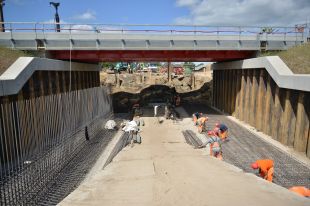EU – Baltic States, Legislation, Lithuania, Railways, Transport
International Internet Magazine. Baltic States news & analytics
Monday, 12.01.2026, 00:43
Vilnius does not refuse to raise train speed on Rail Baltica, but doesn’t see that as priority
 Print version
Print version |
|---|
In the opinion of Arijandas Sliupas, Deputy Transport Minister, train speed can always be increased in the future.
Lithuania did not reject the idea of increasing train speed on the section of the European-standard gauge railway between Kaunas and the border with Poland but did not consider that as the key priority, he said.
RB Rail, a joint venture established by the Baltic countries for the Rail Baltica project, should soon issue a tender for a study, which would analyze ways to increase the speed on this section, the official said.
“Now the joint venture has to carry out an assessment, which will evaluate two alternatives – whether to consider, in general, building a new line [between Kaunas and the border with Poland] within the framework of this project or to adjust the existing line,” Sliupas told BNS, adding that the study should be completed by the end of the year.
The railway section between Kaunas and the border with Poland, which was completed last year, is now adapted to passenger trains travelling at speeds of up to 120 kilometers per hour.
However, Henrik Hololei, Director General for the European Commission’s Directorate General for Mobility and Transport, has recently told the Estonian daily Postimees that speeds should be increased to 240 kilometers per hour if Lithuania wants this section to be considered as part of Rail Baltica.
According to Sliupas, Poland, which has not yet given a clear answer, also has to make up its mind as regards train speed on the Rail Baltica line. However, the official says that Poland can do that at a later stage since the current key priority of the Baltic countries is to establish a European-standard gauge rail connection between the three states.
The line built between Kaunas and the border with Poland had been adapted to slower speeds since the European Union (EU) had set different objectives at that time, he said. The 120-kilometer section, worth more than 370 million euros, was opened last October.
“That section was built on the basis of older EU decisions, which, in accordance with the initial idea of Rail Baltica, actually envisaged the construction of a European-standard gauge to Kaunas and the reconstruction of the Russian-standard gage from Kaunas to as far as Tallinn. Debates that it is also necessary to consider a possibility to achieve the speed of 240 kilometers per hour only emerged in 2010. The project actually started up in 2014 when money had already been spent while we followed the documents adopted before that moment,” Sliupas said.
Transport Minister Rimantas Sinkevicius told BNS that if Poland, which would have a 431-kilometer long section of Rail Baltica crossing its territory, decided to build a line adapted to the speeds of up to 240 kilometers per hour, Lithuania would also increase the speed on its section.
Lithuania planned to install a control system, which would be suitable for the speeds of both 120 and 240 kilometers per hour, on the section between Kaunas and the border with Poland, he said, reminding that the country had asked the European Commission to provide 75 million euros to finance the installation of the system.
Another section of Rail Baltica, which will be built between Kaunas and the border with Latvia, will be adapted to train speeds of up to 240 kilometers per hour.








 «The Baltic Course» Is Sold and Stays in Business!
«The Baltic Course» Is Sold and Stays in Business!

